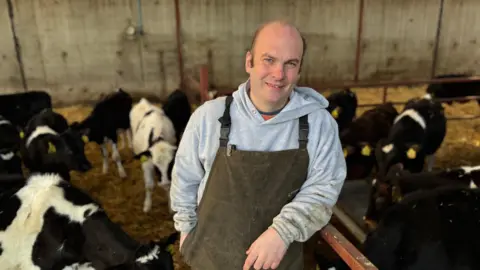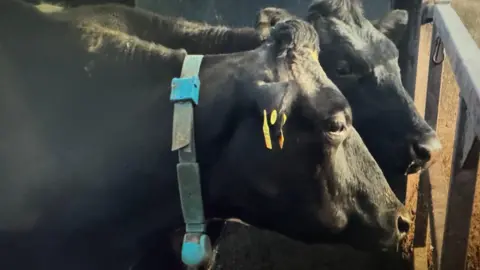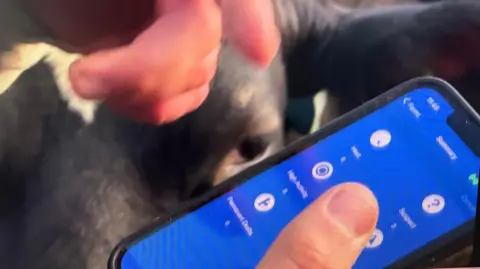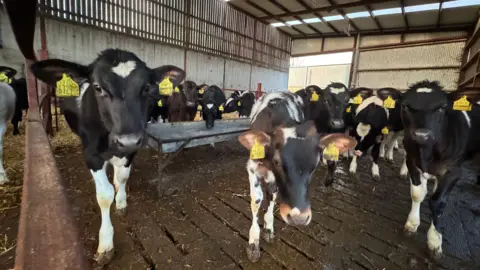The cows wearing smart collars to measure activity
 BBC
BBCFrom monitoring animal activity to predicting the best time for insemination to support genetic improvement, apps are playing an increasing role in farming and reducing its impact on the environment.
Modern technology has transformed Hugh Harbison's family farm in Aghadowey in County Londonderry.
His cows wear electronic collars so he can monitor how active they are and when his best producers are ready for insemination.
For Hugh it's about being both "profitable, and sustainable as well".
Farmers say they'll need help to play their part in achieving targets like a 48% reduction in overall emissions.
Hugh got involved when he got "fed up with farmers copping a lot of flak" about their emissions.
Agriculture is responsible for the largest share of Northern Ireland's greenhouse gases.
That includes methane from cattle, which is a significantly more potent GHG than carbon, having a greater impact in its shorter life.
There are more than 3,000 dairy farms in Northern Ireland and the dairy sector is a significant economic player in agriculture.
Managing emissions from these cattle is key to tackling their environmental impact.
That means improving efficiency in the herd - the same number of animals producing more and better milk.
Better milk
Increasing that efficiency is a complex process though, involving analysis of the grass and feed the cows eat and scientifically monitoring their output.
Among the changes Hugh brought in after taking over Ballydevitt farm in 2012 was joining the ARC Zero project, which opened his eyes to the role the environment was playing in his farm management.

The whole farm was surveyed.
"We did a calculation to work out how much tons of carbon dioxide emissions were emitting from the cows that produce the milk that we produce on this farm and that gives us the baseline then to look at what our nitrous oxide emissions, carbon emissions and methane are, where they're coming from, and how we can improve that?"
The collars the cows wear for monitoring activity mean he is breeding off his best animals all the time to improve his genetic stock.
And it shows in the milk they produce.
"We've increased our fat and protein percentages by over half a percent over the past five years. We've also increased our milk from forage (farm-grown feed) from 2,500 acres to 3,500 acres over that period of time," he told BBC News NI.
"So those figures, you know, they make us both financially sustainable and environmentally sustainable as well."
180-strong dairy herd

And, he has focused on what his soil can produce to feed his 180-strong dairy herd at Ballydevitt farm, rather than buying in feed and fertiliser that come with both financial and carbon cost.
"We've increased more clover into the swards that the cattle graze, we've tried to increase multi-species swards using plantain and chicory.
"It's a slow burn, it's a learning curve.
"It's not going to change overnight, but I suppose those things are making a drastic change on our environmental and our financial sustainability as well."
Environmental sustainability in dairy farming is the theme of the Dairy Council's annual Sustainable Dairy Conference, taking place on Wednesday.
The Council CEO Ian Stevenson said it goes "hand in hand" with social and economic sustainability.
"Worth almost £1.5bn annually, the dairy sector is an important pillar in rural communities throughout Northern Ireland.
"Taking an evidence-based approach to sustainability is key to improving the dairy sector's environmental footprint and lowering emissions, and as we will be hearing during the CAFRE and DAERA Presentations, Northern Ireland is punching above its weight in providing a reliable evidence base for future decision-making and partnership working."
Farmers need help

In Hugh's words, "it's not one big thing, it's just baby steps all the time," but farmers need help.
"We've identified that we can drive efficiencies on farm but we're going to need support from the relevant department.
"We got facts and science-based evidence to prove that we can be part of their solution, not part of the problem.
"But everybody has to work together to try and achieve the same goals."
